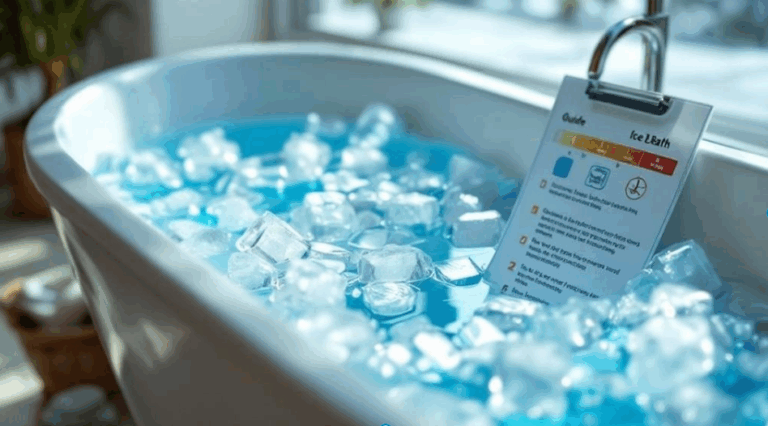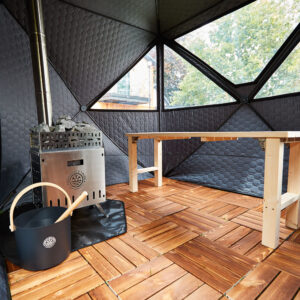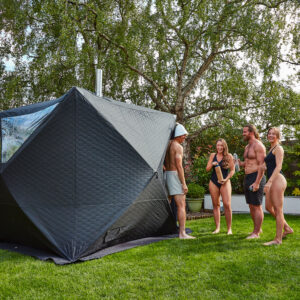
Ice Baths: A Key to Enhanced Recovery and Vitality for Athletes
Explore how ice baths can boost recovery and enhance vitality for athletes. Discover practical tips and insights to elevate your performance. Read more!
Spend Over £500 To Get Free UK Delivery - Excludes Certain Postcodes & Round Ice Baths

You might think maintaining an ice bath’s temperature is a difficult task, but with the right technique and equipment, it’s more manageable than you think. Imagine investing in a high-quality ice bath that possesses an insulating design, capable of retaining the cold for a prolonged period. You can make ice for your ice bath by freezing water in molds or containers, creating ice blocks that are perfect for immersion. Storing small bits of ice is a convenient way to have enough on hand for your next cold plunge session. But that’s just the tip of the iceberg. There’s a whole world of advanced equipment and strategies, including specialised products that will help you optimise your recovery process. Let’s unpack these possibilities further.

While you might view cold therapy as a simple concept, there’s actually a complex science behind it. The significance of maintaining an ideal ice bath temperature between 3 and 15 degrees Celsius is rooted in the effects of cold water immersion on blood flow and circulation.
When you immerse your body in cold water, your blood vessels constrict, redirecting blood from your skin to your core. This reduction in blood flow to the skin and extremities helps to minimise inflammation and muscle soreness. At the same time, cold water immersion stimulates circulation, which helps remove waste products from muscles and accelerates the healing process. Submerging the body also causes a drop in body temperature, so controlled cooling is important to avoid risks like hypothermia and cold shock.
However, achieving and maintaining this temperature range is essential. Too cold, and you risk frostbite; too warm, and the therapeutic benefits diminish.
Understanding this science can help you maximise the benefits of cold water immersion in your recovery routine.

Although it may seem counterintuitive, regular ice baths can provide many health benefits that extend beyond simple muscle recovery.
Immersing your body in cold water, a practice known as cold water therapy, helps reduce muscle soreness post-workout. It’s not just about physical recovery, though. Your mental health can benefit too, with improved mood and reduced stress levels being notable outcomes.
Dive into cold water therapy – it not only soothes post-workout aches but also uplifts mood and lowers stress levels.
Additionally, your immune system gets a boost, potentially leading to fewer colds and infections.
It’s important to remember that these health benefits are most effectively reaped through consistent and correct use of ice baths, always with an eye on safety. To maximise these benefits, make sure to take an ice bath at the optimal temperature and duration, following recommended guidelines for safe and effective recovery.

Achieving the perfect ice bath temperature is the most important thing you can do to unlock the many benefits of cold water therapy. The ideal ice bath temperature sits between 3 and 15 degrees Celsius, with the sweet spot for most people being 10 to 12 degrees Celsius. This range is proven to help reduce muscle soreness, speed up recovery time, and even boost mental clarity after an intense workout or a long day.
To reach your desired temperature, start by filling your bath with cold water, then add ice cubes or larger ice blocks. A good rule of thumb is to use one part ice for every three parts water, but you can adjust this ratio depending on the size of your tub and how cold you want the water. If you’re looking for a more cost effective and eco-friendly approach, frozen bottles of water are a great option, they freeze faster, last longer, and can be reused for your next dip.
For those who want precise temperature control, investing in a chiller system or using a reliable thermometer is essential. This allows you to monitor the water temperature closely and avoid too cold temperatures, which can be uncomfortable or even risky. Remember, the goal is to keep the water cold enough for optimal recovery, but not so cold that it becomes unsafe.
When preparing your ice bath, consider the size of your ice blocks. Larger ice blocks and frozen bottles melt more slowly, providing a longer-lasting cooling effect compared to smaller ice cubes. Make sure to leave enough space in the bath for the ice to expand and for the water to circulate freely, this ensures even cooling and full body immersion. The surface area of your bath also plays a role: a wider tub allows for faster cooling and more efficient use of ice.
To maintain your ice bath at the right temperature, keep it away from direct sunlight and sources of heat. Placing your bath in a shaded area or using a weather cover or lid can help reduce heat gain and keep the water colder for longer. This is especially important during summer or if you’re using your ice bath outdoors.
Finally, always consider your health and safety. If you have high blood pressure or any concerns about how your body might react to cold water immersion, consult your doctor before starting a new routine. Cold water causes blood vessels to constrict, which can temporarily raise blood pressure, so it’s important to listen to your body and take precautions.
By carefully preparing your ice bath—choosing the right temperature, using the best ice options, and considering environmental factors, you’ll maximise the health benefits of cold water therapy. Whether you’re aiming to reduce muscle soreness, improve recovery time, or simply add a refreshing ritual to your daily routine, a well-prepared ice bath can make all the difference.

If you’re looking for an eco-friendly and cost-effective solution to keep your ice bath cold, consider using frozen bottles. This method not only guarantees the ideal water temperature but also reduces waste.
1. Preparation: Fill your bottles with water and stick them in the freezer.
You’ll want a good stock of frozen bottles ready to go, as you’ll need several to lower the bath’s temperature effectively.
2. Usage: When it’s time for your ice bath, simply add the frozen bottles.
They’ll gradually release cold as they melt, keeping the bath at the right temperature.
3. Monitoring: Keep an eye on the water temperature.
If it starts to rise, add more frozen bottles.
This approach is a practical, green way of maintaining your ice bath, guaranteeing your body gets the ideal recovery benefits.

Ensuring the quality of the water in your ice bath is paramount to achieving the best recovery outcomes.
It’s not just about temperature; the water’s cleanliness plays a vital role too. Pure, clean water allows for better conductance of cold, enhancing your ice bath’s effectiveness.
Clean water isn’t just about purity; it’s key to enhancing your ice bath’s effectiveness through better cold conductance.
The presence of contaminants can affect temperature stability, undermining the benefits of your regimen. So, make sure to keep your ice bath water clean and free from impurities.
Regularly change the water, disinfect the bath, and avoid introducing contaminants like sweat or dirt.
Maintain the ideal temperature range between 10-15°C for ideal muscle recovery.

Undeniably, blood flow is an essential factor in the process of recovery after strenuous physical activity.
When you immerse yourself in an ice bath, cold temperatures cause your blood vessels to constrict, redirecting blood flow from the extremities to the core.
This process has three key effects on muscle recovery:
Thus, understanding and harnessing the effects of blood flow in cold temperatures is critical for peak muscle recovery.
While understanding the role of blood flow in recovery is key, managing your blood pressure during cold water therapy sessions shouldn’t be overlooked.
When you immerse in cold water, your body responds by constricting blood vessels, thereby temporarily increasing blood pressure. This spike might pose a risk if you’re already grappling with high blood pressure. Consequently, it’s crucial to monitor your blood pressure before and after sessions.
Gradually acclimatising yourself to the cold can help manage these sudden changes. Additionally, maintaining regular breathing can stabilise your blood pressure.
If you regularly engage in strenuous physical activities, you’ll find that incorporating a regular cold plunge into your routine can offer significant benefits. Here’s why:
To truly maximise the benefits of cold water therapy, you might consider incorporating advanced techniques into your recovery routine.
A key component of these techniques is a chiller system, which provides precise temperature control, essential for ideal recovery. This system continuously circulates water, maintaining your ice bath at an ideal temperature range, saving you the constant hassle of adding ice.
It’s a game-changer in cold therapy, enhancing the effectiveness of each session. Coupled with other advanced techniques, like gradual immersion and controlled breathing, you’ll see a significant boost in your recovery process.
However, always remember to consult a medical professional before incorporating these techniques, ensuring they align with your health needs and goals.
Despite the numerous benefits of cold water therapy, it’s crucial to prioritise safety during each session.
Prioritizing safety is key while reaping the numerous benefits of cold water therapy.
There are specific safety precautions you need to consider to harness the full benefits of cold therapy while minimising risks:
Ensuring your ice bath functions effectively isn’t a one-time job; regular maintenance is an essential factor in maintaining its efficiency.
It’s important to routinely monitor the water temperature, ensuring it remains within the ideal range for recovery. Any fluctuations can hinder the therapeutic effects, so it’s vital to keep a consistent temperature.
A well-maintained ice bath is more efficient, providing the best conditions for muscle recovery. Regular cleaning is also necessary to prevent buildup that can affect performance.
Remember, neglecting maintenance can result in an inefficient ice bath, compromising its coldness and your recovery process.
As a result, don’t underestimate the power of regular maintenance in enhancing your ice bath’s efficiency and your overall recovery.
If you’re looking to maintain precise temperature control for your ice bath, consider adopting the use of chiller units.
Specifically, the Urban Ice Tribe Wedge Temp Control Units come highly recommended.
Investing in a chiller unit, consequently, enhances your ice bath routine for optimal recovery.
For ideal recovery, you’ll want to soak in your ice bath for 10-15 minutes. It’s long enough to stimulate muscle recovery, yet short enough to prevent potential hypothermia. Always listen to your body’s responses.
You should consult your doctor before starting cold water therapy during pregnancy. While it may aid recovery, it could have unexpected effects on your body’s temperature regulation, potentially posing risks for both you and your baby.
You should take ice baths 2-3 times a week for ideal recovery. However, it’s important to listen to your body and adjust accordingly. Consult your doctor before starting any new recovery regimen.
Yes, age and body size can influence cold water therapy’s effectiveness. Your body’s heat production and retention capabilities vary, affecting how you respond to the treatment. Always tailor your therapy to your individual needs.
You’re unlikely to catch a cold from frequent ice baths. Colds are caused by viruses, not temperature. But remember, if you’re overdoing it or not warming up properly post-bath, your immune system might be compromised.
Just like a well-oiled machine, your ice bath needs regular maintenance and careful monitoring for ideal recovery benefits. From investing in a quality ice barrel to utilising frozen bottles and advanced chiller units, each step plays an essential part in maintaining a cold bath. Remember, the key is not just about keeping the water cold, but ensuring a clean and safe environment. So, make your recovery as smooth as a skater gliding on ice by following these tips.

Founder of Urban Ice Tribe

Explore how ice baths can boost recovery and enhance vitality for athletes. Discover practical tips and insights to elevate your performance. Read more!

There’s nothing quite like the raw, elemental power of a pop-up sauna. Portable, authentic, and deeply restorative, it’s the perfect way to reconnect with nature and yourself. But to take your sauna ritual to the next level, the right sauna accessories can make all the difference.

Transform your outdoor space into a personal wellness retreat with the Urban Ice Tribe Sauna Tent. This detailed setup guide walks you through every step, from unboxing to your first steam session, blending practical instruction with the mindful ritual of heat therapy.
Helping men & women release anxieties & limiting beliefs to experience a life of freedom using powerful breathwork, cold water therapy, movement & sound healing.

No spam, notifications only about new products, updates, offers and announcements.